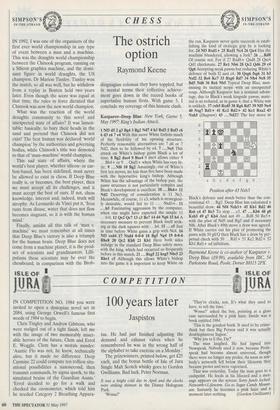SIMPSON'S
IN-THE-STRAND
SIMPSON'S
IN-THE-STRAND
CHESS
The ostrich option
Raymond Keene
IN 1992, I was one of the organisers of the first ever world championship in any type of event between a man and a machine. This was the draughts world championship between the Chinook program, running on a Silicon graphics machine, and the domi- nant figure in world draughts, the US champion, Dr Marion Tinsley. Tinsley won the match, so all was well, but he withdrew from a replay in Boston held two years later. Even though the score was equal at that time, the rules in force dictated that Chinook was now the new world champion.
What was the reaction of the world draughts community to this novel and unexpected state of affairs? It was lamen- table: basically, to bury their heads in the sand and pretend that Chinook did not exist! The best human was declared 'world champion' by the authorities and governing bodies, while Chinook's title was demoted to that of 'man—machine' world champion.
This sad state of affairs, where the world's best player, whether silicon- or car- bon-based, has been sidelined, must never be allowed to exist in chess. If Deep Blue really is, or becomes, the best player, then we must accept all its challenges, and it must accept the best of ours. If not, chess knowledge, interest and, indeed, truth will atrophy. As Leonardo da Vinci put it, 'Iron rusts from disuse, water that does not flow becomes stagnant, so it is with the human mind.'
Finally, amidst all this talk of 'man v. machine' we must remember at all times that Deep Blue's victory is also a triumph for the human brain. Deep Blue does not come from a machine planet, it is the prod- uct of scientists and grandmasters. Lilli- putians these scientists may be over the chessboard, in comparison with the Brob- dingnagian colossus they have toppled, but in mental terms their collective achieve- ment goes down in the record books of superlative human firsts. With game 5, I conclude my coverage of this historic clash.
Kasparov—Deep Blue: New York, Game 5, May 1997; King's Indian Attack.
1 Nf3 d5 2 g3 Bg4 3 Bg2 Nd7 4 h3 Bxf3 5 Byd3 c6 6 d3 e6 7 e4 With this move White forfeits much of the flexibility of his opening structure. Perfectly reasonable alternatives are 7 d4 or 7 Nd2, then to be followed by e4. 7 ... Ne5 This attack on White's bishop gains Black a lot of time. 8 Bg2 dxe4 9 Bxe4 9 dxe4 allows either 9 ...Bb4+ or 9 ... Qxdl + when White has very lit- tle. 9 ...Nf6 10 Bg2 Amazingly, out of White's first ten moves, no less than five have been made with the hyperactive king's bishop. Although White has the advantage of the bishop pair, the pawn structure is not particularly complex and Black's development is excellent. 10 ...Bb4+ 11 Nd2 Deserving of consideration is 11 Nc3. Meanwhile, of course, 11 c3, which is strategical-
ly desirable, would fail to 11 Nxd3+. 11 ...h5 Fascinating aggression by the computer, when one might have expected the simple 11 ... 0-0. 12 Qe2 Qc7 13 c3 Be7 14 d4 Ng6 15 h4 A necessary measure to prevent Black itself strik- ing at the dark squares with ... h4. 15 ...e5 Just in time before White gains a grip with Nc4. 16 Nf3 exd4 17 Nxd4 0-0-0 18 Bg5 Ng4 19 0-0-0 Rhe8 20 Qc2 Kb8 21 Kbl Here both sides indulge in the standard Deep Blue safety move with the king, which had occurred so frequently before in this match. 21 ... BxgS 22 hxg5 N6e5 23 Rhel c5 Although this allows White's bishop into the game it is important to keep White on the run. Kasparov never quite succeeds in estab- lishing the kind of strategic grip he is looking for. 24 N13 Rxd1+ 25 Rxdl Nc4 26 Qa4 Has the machine blundered, allowing a fork? 26 ...Rd8 Of course not. For if 27 Rxd8+ Qxd8 28 Qxc4 Qdl checkmate. 27 Rel Nb6 28 Qc2 Qd6 29 c4 Qg6 Accepting weak pawns but reducing White's defence of both f2 and c4. 30 Qxg6 fxg6 31 b3 Nxf2 32 Re6 Kc7 33 Rxg6 Rd7 34 Nh4 Nc8 35 Bd5 Nd6 36 Re6 Nb5 Typical Deep Blue, max- imising its tactical scope with an unexpected coup. Although Kasparov has a nominal advan- tage, due to Black's weak kingside pawns, mate- rial is so reduced, as in game 4, that a White win is unlikely. 37 cxb5 Rxd5 38 Rg6 Rd7 39 Nf5 Ne4 40 Nxg7 Rdl+ 41 Kc2 Rd2+ 42 Kcl Rxa2 43 NxhS (Diagram) 43 ...Nd2!! The key move in
Black's defence and much better than the con- ventional 43 ...Rg2. Deep Blue has calculated a beautiful draw. 44 Nf4 Nxb3+ 45 Kbl Rd2 46 Re6 c4 47 Re3 To stop ...c3. 47 ...Kb6 48 g6 KxbS 49 g7 KM And not 49 ... Rd8 50 Re5+ with the plan of Nd5 and Rg5 and if necessary Nf6. After Black's 49th move a draw was agreed. If White carries out his plan of promoting the pawn with 50 g8/Q then Black has a draw by per- petual check with 50 ... Rdl+ 51 Kc2 Rd2+ 52 Kbl Rdl+ ad infinitum.
Raymond Keene is co-author of Kasparov v. Deep Blue (£9.99), available from IBC, 54 Parkstone Road, Poole, Dorset BH15 2PX


































































 Previous page
Previous page